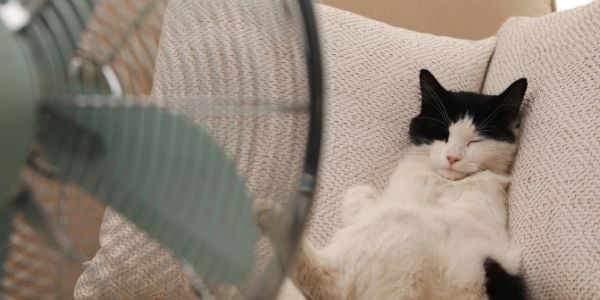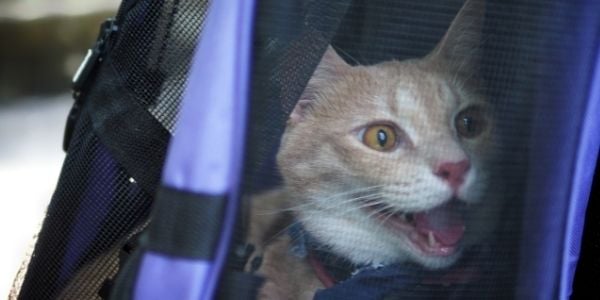
Heatstroke can occur quickly in certain circumstances but almost always starts with serious but less severe heat exhaustion.
A dog or cat with heat exhaustion can be treated at home if it is caught early.
Heatstroke is an emergency that will be fatal if action is not taken immediately.
It is important to know the early signs of heat exhaustion and how to treat it so that your pet does not progress to the life-threatening stage of heatstroke.
Can Cats Get Heatstroke?
While cats can suffer from heatstroke, it doesn’t happen as often as with dogs. For example, cats don’t tend to go for car rides around town like dogs do, and most people don’t take their cats jogging or for marathon playtime sessions at the park.
Cats also tend to do a better job of seeking out cooler areas when they need to.

What Is Heatstroke
The normal body temperature for a dog or cat is between 99°F and 102°F degrees. Heatstroke occurs when their temperature rises above 104°F, and they can no longer cool themselves using their body's natural cooling systems.
A dog cools off by panting, as well as sweating through their paw pads.
Cats cool themselves by sweating through their paw pads as well as by grooming themselves. They lick their coat, and the saliva has a cooling effect as it evaporates from their fur. Cats also pant like dogs. However, a cat that is open mouth breathing for longer than 10 to 30 seconds at a time may be in the early signs of heat exhaustion.
When these methods fail, and the body temperature continues to rise, all organ systems will fail. This includes the urinary, circulatory, neurologic, and clotting systems.
Heatstroke always starts with the signs of heat exhaustion, so be on the lookout, as a progression to heatstroke can be fatal.
Signs of Heat Exhaustion in Dogs and Cats
There are varying degrees of these symptoms, how obvious or severe they are, or even how many are noticeable at once. It all depends on the situation and how long your pet has been in the heat.
- Persistent and prolonged panting
- Rapid pulse – you’ll notice their chest rising and falling quickly
- Labored breathing
- Seeking out shade or sources of water
- Moving more slowly than normal
- Wide, stressed eyes
- Dark pink gums and tongue
- If parked in a car, these signs may also be seen
- Barking
- Pacing
- Clawing at the window or seats or dash – trying to escape
- Attempts to stick their head out of or escape through a cracked window
- Hiding in a shaded area, like under the dash or seat
- Slobbery nose or paw prints on the inside of the windows
Signs of Heatstroke in Dogs and Cats
Again, there are varying degrees and severities of these signs, and not all will be present in every case. Also, note that the signs listed below are in addition to the signs listed above for heat exhaustion, and there is considerable overlap.
- Vomiting – possibly containing blood
- Diarrhea – possibly containing blood
- Drooling
- Dry, sticky gums
- Dark red gums
- Fast, thready pulse
- Glazed-over eyes
- Staggering
- Collapse
- Unresponsiveness or apparent signs of an altered mental state
- Seizures
- Bruising of the skin or the gums (these small, pinpoint bruises, called “petechiae," are often most visible inside the ears or on the underside of the belly)
When Is Heatstroke an Emergency for Your Pet?
Heatstroke is a devastating emergency and a horrible thing for a pet (and the people who love them) to suffer.
How do you know when your pet is tired or has “overdone” it versus a true emergency that requires a trip to the ER? Anytime your dog or cat is out in the heat and is panting without any breaks of closed-mouth breathing, you should be on high alert.
Basic treatment for heatstroke involves removing your pet from the heat and offering water and shade. If the panting does not stop, or they will not get up or have dark red mucous membranes (like their gums), they need to be seen immediately by a veterinarian.
Questions? If you're concerned your pet may be suffering from heatstroke and would like to speak with a veterinarian, Click here
Is Your Dog or Cat at Risk of Heatstroke?
Along with the outside temperatures and humidity and the situations that people may put and leave their pets in, there are several other pet-specific factors that can increase a pet’s risk for suffering from heat exhaustion and heatstroke.
If your cat or dog has one or several of the characteristics or conditions listed below, they may be at increased risk of suffering from heat-related illnesses. Please take extra precautions on warm, hot, and humid days.
Young or Advanced Age
Because of the decreased ability to regulate their own body temperature, very young and very old cats and dogs are at increased risk of developing heatstroke.
Excessive Weight
Pets who are overweight or obese are more likely to develop heatstroke because of the increased insulation of the fat cells, along with the increased heat overweight pets generate during even mild exercise. Speak with your veterinarian and check these body charts for dogs and for cats to determine their ideal body condition.
Brachycephalic Head ('Flat-Faced') and Shorter Airway Conformation
Because of the overall structure of their breathing (respiratory) system, brachycephalic (flat-face) cats and dogs are very much at increased risk for suffering from heatstroke.
At-risk dog breeds include Bulldogs (English, French, and American), Boxers, Pekingese, Shih Tzus, and similar breeds – as well as flat-nosed mixes of these breeds. At-risk cat breeds include Persian, Himalayan, British Shorthair, and Scottish Fold – as well as flat-face mixes of these breeds.
Existing Medical Conditions
Cats and dogs with arthritis or certain other orthopedic conditions are at increased risk for developing a heat-related illness. For example, an older pup or kitty with arthritis may wander into the sunshine (even inside by a window) and not be able to get back into the shade.
Similarly, dogs with respiratory conditions such as collapsing trachea, laryngeal paralysis, or brachycephalic obstructive airway syndrome are at grave risk of developing heatstroke. In addition, cats and dogs with certain heart conditions and dogs with myasthenia gravis or Addison’s Disease are also at higher risk.
Coat Characteristics
Cats and dogs with thicker, darker-colored coats are at increased risk of suffering from heatstroke compared to pets with thinner, lighter-colored coats due to the greater insulating and heat-absorbing characteristics of the thicker, darker-colored fur.
Shaving a pet’s coat shorter does not necessarily make them less prone to heatstroke and can actually make it harder for them to stay cool.
When Heatstroke Happens and How to Prevent It
Multiple scenarios can lead to heatstroke in your pet. When most people think of heatstroke, they imagine a dog left inside a car on a warm or hot day. This is one of the most common scenarios, but there are many more.
The situations listed below are not an exhaustive list. But knowing when heatstroke can occur, planning ahead, and knowing how to react when your dog or cat is showing signs of heat exhaustion or heatstroke can prevent this deadly syndrome.
Trapped Cats
These scenarios can lead to heat exhaustion and, subsequently, heatstroke for cats.
- Becoming trapped in a clothes dryer (this is not an infrequent occurrence)
- An outdoor cat getting trapped in a shed or other “oven-type” structure during a hot period
- A cat left confined, like in an enclosed lanai or catio area, without ready access to water and shade
Inside Cars and Other Vehicles
Multiple studies have shown how rapidly the temperature can rise in a parked car, even with the windows “cracked” and even on relatively mild days.
- In one study, it took just 10 minutes for the temperature inside a car to go up 19°F Fahrenheit in 10 minutes. And it went up 29°F in 20 minutes, with a 34°F rise in 30 minutes and 43°F in 60 minutes.
Anybody who has sat in a parked car on a warm day will appreciate just how uncomfortable any of those increases can be, and just how short a time 10 minutes is. - In the same study, on one of the (very mild) 72°F days, the temperature inside the car reached a dangerous 93°F in just 10 minutes! And it climbed from there to devastating and deadly levels quickly – reaching 105°F in 20 min., 110°F in 30 min., and 119°F in 1 hour!
As you can see, when it is hot outside, heat stress can progress rapidly to a debilitating and potentially fatal case of heatstroke for a dog or cat left in a parked car for as few as 10 minutes.
Even on a relatively mild 65–75°F day, 15–20 minutes of enclosure in a parked car can be enough to bring on a case of heatstroke. And this is true regardless of whether the windows are cracked.
The key to prevention is to NOT take your pet in the car with you on warm days – and remember, warm can be 65°F – or even 55 degrees if your car is parked in the sun. This also applies to taking your dog out in a pickup truck.
The bed of the truck is metal and can reflect the sun making the temperature rise dangerously, as well as burning your pet’s paw pads.
Find out what you can do if you see a dog or cat in a hot car and whether it's legal to break the window to rescue an animal.
This dog (video below) is in the early stages of heat stress on an 86°F day in a car parked in a covered parking garage. The windows were cracked.
Note the non-stop panting. We have no idea just how hot it was in that car or what the dog's internal temperature was at that point. However, it's clear that the dog was too hot and well on his way to developing heat exhaustion and potential heatstroke.
Questions? If you're concerned your pet may be suffering from heatstroke and would like to speak with a veterinarian, Click here
Heatstroke Risk During Travel
Travel — be it by car, RV, or plane — can put your pet at risk of suffering from heatstroke. The dangers are present both during the journey and even once you arrive at your destination. Be aware that your pet may need time to acclimate to the temperatures and humidity levels at your final destination.
If you’re traveling by air and planning to put your pet in the plane’s cargo hold, read this article to help prepare for the best plane travel possible.
Heatstroke During Exercise, Play, or Even Walks With Dogs
Just like us, dogs generate heat when they play and exercise. Unlike us, however, dogs cannot sweat to cool their body. They mainly depend on panting to get rid of excessive heat. Dogs will not “police themselves” on warm days. They will play and play until they collapse.
For dogs with certain medical conditions — including brachycephalic syndrome, collapsing trachea, and laryngeal paralysis, even a short walk around the block during the warmer parts of the day can spell disaster.
Walk your dog or play outside during early morning or late afternoon hours when the sun is less intense. Give your dog plenty of opportunities to drink (just not too much as it can lead to stomach torsion and Gastric Dilatation and Volvulus (also known as “bloat”).
And if your dog wants to take a break – they slow down or lie down – listen to them! Don’t push them. Give them time to recuperate.
In general, dogs with flat faces (Pugs, Boston Terriers, and bulldog breeds) should just not go outside or on walks on hot days. Their airways are already restricted due to their anatomy, and they are best left inside a cool home to relax. Check out some of these ideas for keeping your dog cool on hot days.
Heatstroke When Left Outside
Dogs who live outside or those who spend large amounts of time outdoors during warmer days are at risk of suffering from heatstroke, too. Reliable shade, plentiful water, and protection from hot asphalt and other surfaces that can reflect heat are important to protect outdoor dogs.
On hot days, consider bringing your dog inside to avoid heat exhaustion or stroke. Depending on where you live, that might even be the law.
For cats, make sure you see your outdoor cat every day to ensure (among other things) they’re not trapped in a shed or elsewhere.
History of Heat Illness
Cats and dogs who have previously suffered through and survived a bout of heatstroke are at increased risk of suffering from a future case of heatstroke due to a change in their hypothalamic temperature set point resulting from their initial heat injury.

How to Minimize Heatstroke Risk in Cats and Dogs
For Dogs:
- Walk or exercise outdoors during cooler times of the day.
- Don’t walk or exercise your brachycephalic dog on hot days.
- Provide easy access to water at all times.
- Pay attention to the signs of heat stress.
For Cats:
-
Ensure that your cat always has easy access to plenty of fresh, cool drinking water.
-
If you don’t already do so, consider adding some canned food to your cat’s meals during the warmer days of the year. This provides additional hydration in case they don't drink enough.
-
Encourage your cat to drink with tuna water or another enticer so that they drink more, especially on hot days.
- Pay attention to the signs of heat stress.
Want to be part of the solution in helping prevent heatstroke in cars? Download the #HotHappensFast poster and start spreading awareness!




